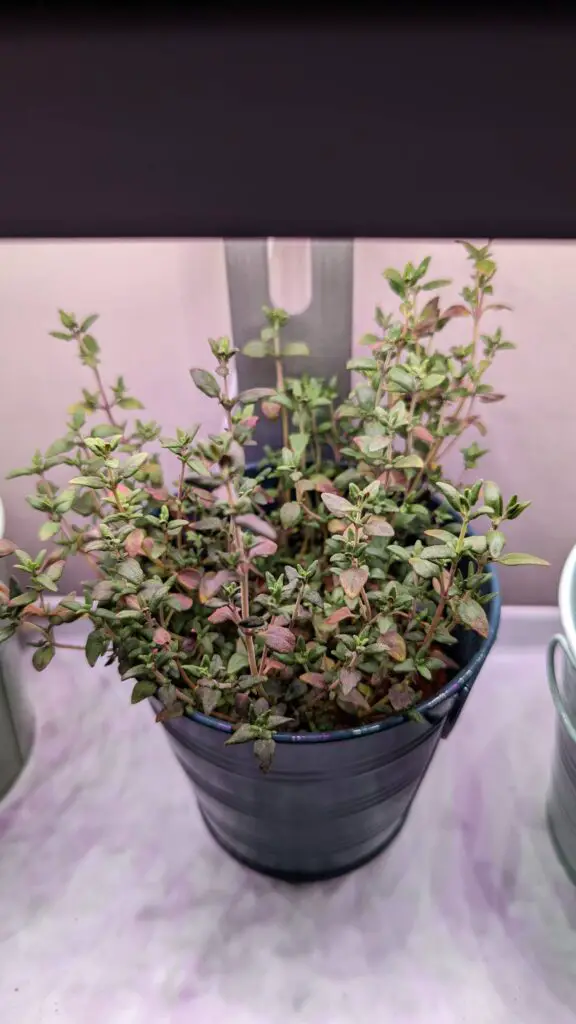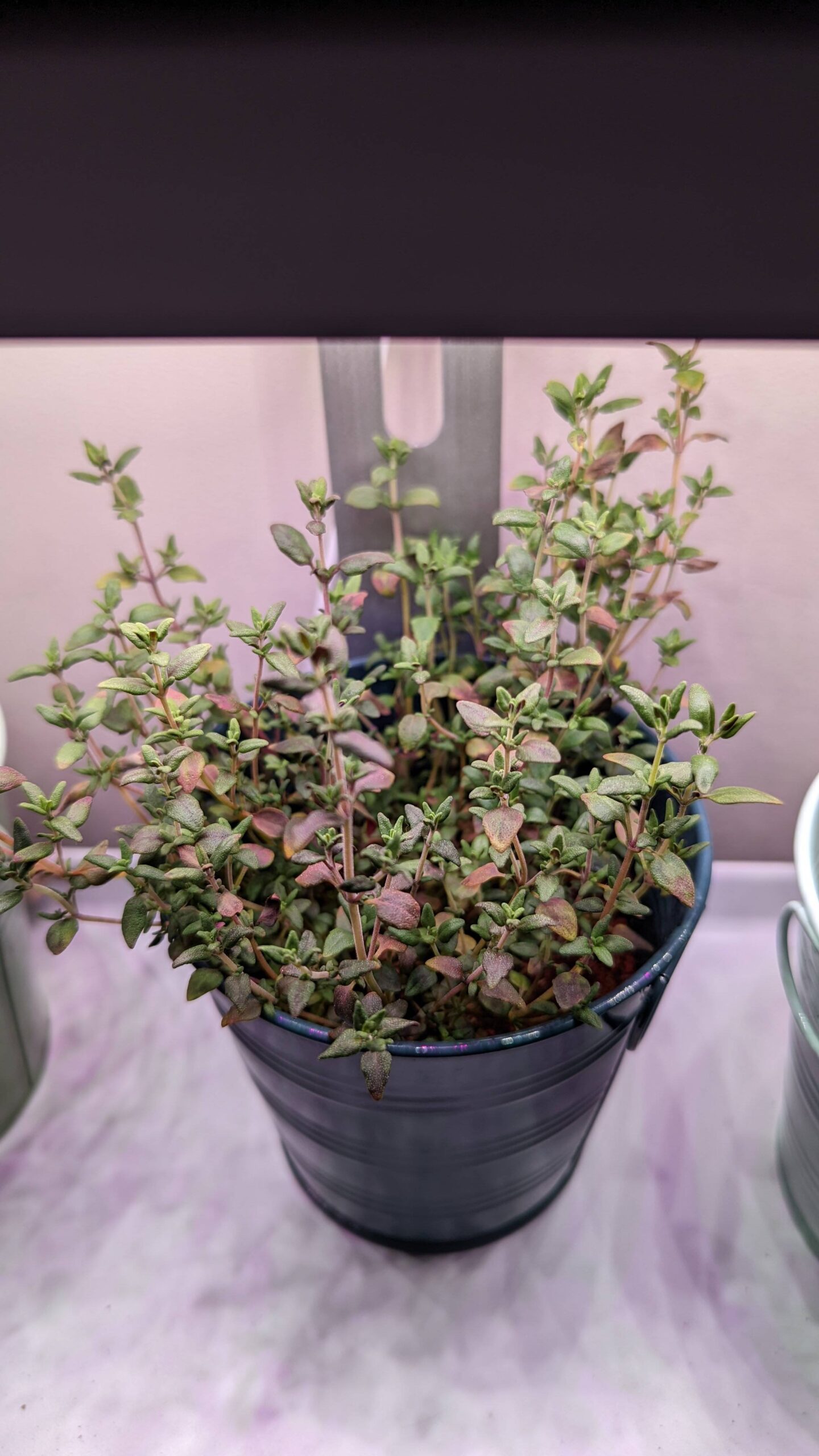Thyme leaves turning purple from green can prompts a garden enthusiasts worst thoughts! But, it doesn’t have to be so as there is a simple reason for it, one that can be fixed quite easily.
Thyme leaves turning purple is a sign of phosphorous deficiency. Solve this by providing your thyme plant with more phosphorous either with an inorganic or organic source of the mineral.

Facing other problems with respect to thyme foliage discoloration? Read: How to Fix Thyme Leaves Turning Brown?
Read on to find out more about thyme leaves turning purple.
Reasons Why Thyme Turns Purple
There are many reasons that might cause your thyme plant to discolor. It could be that the plant:
- Is under attack from pests or disease
- Poor soil can contribute to the plants ill health
- Inadequate drainage
- Too little fertilizer
- Nutrient and mineral deficiency
Sometimes it is a number of factors mentioned above that contribute to a mineral deficiency. The plant displays its stress in the discolouration of the leaves. A commonly asked question from gardeners, is why is my thyme purple or red? Read on as we endeavor to answer your question.
But, completely purple leaved thyme is mostly a cause of phosphorous deficiency.
Phosphorus Deficiency in Thyme
If you notice that the underside of your thyme plant is a reddish purple in color it means that your plant is lacking phosphorus. Juvenile thyme plants are more likely to have a deficiency than mature plants.
Why Does it Happen?
Many may think that phosphorus is easily available in the environment and there are slim to no chances of the plant becoming deficient in this ubiquitous mineral. However you are wrong and your plant can very well face a multitude of problems due to phosphorus deficiency.
- Poor quality solid could have a severe phosphorous deficit.
- Fertilizers that are very low in phosphorous could be the cause.
- Extreme cold can cause create a deficiency of this mineral as these weather conditions affect the plant’s ability to absorb phosphorus from the soil.
- A phosphorus deficiency can be caused by too much iron in the growing media as well as an incorrect pH balance.
What Does It Look Like?
The bottom leaves will be affected first. The dark green leaves will take on a bronze, red or purple hue. Growth can be stunted, and if not attended to, brown spots will appear.
Also, you will notice thyme plants that are smaller (stunted) taking longer to grow and generally of pooer health when siffering from a phosphorous deficiency.
How to Fix?
Most fertilizers and liquids nutrient supplements contain phosphorus as the main ingredient and you might be tempted to just increase the dose. But note that you will be increasing not just the phosphorus, but other minerals too. Which the plant might not need.
As a result you are better off considering organic or inorganic phosphorous. Read on to find out what options are available to you in each category.
Organic Sources
If you choose not to use chemicals for your thyme and other plants, there are some good organic sources of phosphorus. Use them to provide a safer form and amount of phosphorous to your thyme and surrounding garden.
Composted Manure
Organic manure is a great way to bolster the phosphorus content in your plant containers or garden, except that it does not hold a significant amount of phosphorus. However compost made with manure ramps up the phosphorus content. The compost also helps to neutralize the soil and increase the availability of phosphorus.
Fish Meal
This type of meal contains a substantial amount of both phosphorus and nitrogen. This can be advantageous to you if you need to amend the soil with both minerals. The fish meal also releases these minerals quickly.
Bone Meal
Bone meal has a 15% rate of concentration, it has small amounts of nitrogen and is readily available in the soil. It is usually a byproduct of poultry farms and the wastage accrued from them.
Other Rock Sources
Other rock sources such as granite, basalt and greensand are also good sources for phosphorus and can also provide other macro and micronutrients.
Kelp
Kelp are large brown algae seeweeds and is a very unusual source of phosphorus. This is applied as a foliar spray, hence it does not last long. It should be used in unison with a soil amendment fertilizer.
Water
Minute amounts of phosphorus may be found in water but it is not enough to create any ill effects because of excessive amounts. Nor will it help your thyme plant much if it has a severe deficiency of this mineral.
Inorganic Sources
Thyme can get phosphorus from three inororganic sources. These are rock phosphate, superphosphates, and ammonium phosphates. Take a look at each one to find out how they work to help your thyme recover from purple leaves.
Rock Phosphate
For rock phosphate to serve as a source of thyme, it requires acidic soils to break the out and be released. The mineral will not release if it the soil is neutral or alkaline in nature.
Superphosphates (Triple superphosphate)
This is another phosphorus fertilizer component which mostly contains monocalcium phosphate [Ca(H2PO4)2]. It might not be surprising for some but Triple superphosphate is extracted after treating rock phosphate with phosphoric acid. Fertilizers containing this component usually don’t alter soil pH.
Ammonium Phosphates
This is the most common form of phosphorous fertilizer used for garden plants. Not only will it provide phosphorus but nitrogen and sulphur as well! It is commercially available affordable and your thyme may only need one application but you can use it on other plants. In some instance the compound aids in absorption of other minerals.
Dangers of Excessive Amounts of Phosphorus
If you are someone who would rather be safe than sorry when it comes to your plants, we should probably warn you that excessive phosphorus is a trouble.
There can be problems associated with adding too much phosphorus to your garden or farm land, especially if it is an inorganic source of phosphorus. Thyme plants planted in your garden or farm land can face problems because of this soil.
Soils that are soaked with phosphorus can inhibit the growth of soil organisms. Without the organisms the plant has to work twice as hard to put down a good root structure at the expense of stems, aerial roots, leaves, flowers and fruits.
Excess phosphorus can harm the environment, as the inorganic fertilizer can run off into water bodies causing fish to die. It also can cause algal blooms which take up all the oxygen in the water, making it impossible for other organisms to survive.
This pollution of water bodies can then put other animals and birds that depend on the water body at great risk!
All in all it is a problem that extend further than your garden or farm and into the nearby environment putting other animals at risk and even going as far as upsetting the food web.
Purpose of Phosphorus in Plants
Phosphorus plays a crucial role in the well being and growth of your thyme plants. No wonder why phosphorus is a key mineral that’s fixed in almost all fertilizers (N-P-K). Leaving your plant without this mineral will prove to be problematic as phosphorus is a vital mineral.
- Phosphorus improves the fortitude and strength of the plant, helping it to fight disease and other health related issues.
- Plants with easy access to phosphorus tend to fare better against diseases as the plant has better health to fight the infection.
- This element is also essential in the structures DNA and RNA. Phosphorus is a core material for genetic material in plants.
- Phosphorus is vital for carying out a majority of plant processes such as photosynthesis, respiration, food storage and transfer of food to the rest of the plant’s parts.
- ATP production is another compound which needs phosphorus in order to be made.
- Root development in stimulates by the presence of phosphorus.
As you can see, phosphorus is a very important mineral. Also, it plays a major role in most processes in a thyme plant’s lifecycle.
Conclusion
Any sign of thyme leaves changing color can be a bad omen! So thyme leaves turning purple will be worrisome especially if you feel there isn’t much you can do to revert it back to its original green color.
Thyme leave turn purple for a few reasons but the main one is a lack of phosphorus. You have a chance to save your thyme plant by providing it with more phosphorus.
Provide your thyme with more phosphorus using organic materials such as composted manure, fish meal, bone meal, rock phosphate, kelp, and water. Inorganic sources include superphosphate and ammonia phosphate fertilizers.
Wondering if the lavender flowers on your thyme are edible? Are Thyme Flowers Edible? Appearance & Taste
FAQs
Can you eat purple thyme leaves?
Thyme with purple leaves appearing on only the underside are safe to eat. But, the presence of purple leaves only on the underside of thyme leaves are completely normal. However, presence of purple color on the top and the bottom of the leaves is usually a sign of lack of nutrients/minerals and may not be very palatable.

